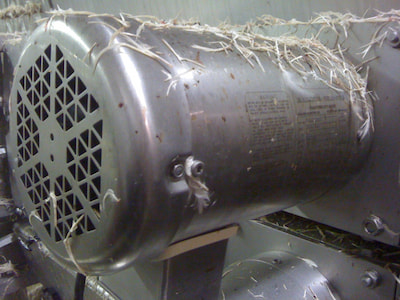As a motor manufacturer looking at the cover photo of the July issue of Pumps & Systems, the focus immediately goes to the alternating current (AC) motor driving the pump. One notices that all the equipment in the room is stainless for ease of cleaning and sanitation. The exception is an International Electrotechnical Commission (IEC) motor and gearbox connected to the pump. A finned frame motor of this type can easily trap food between the fins and behind the motor nameplate, where it will be difficult to remove food debris.
.jpg)
Stainless motor operating a conveyor through a stainles gearbox
Aluminum or cast iron finned frames are standard on metric frame IEC motors. In North America, it is common to have the choice of a smooth steel band motor or cast iron frame on enclosed motors through 20 horsepower built to National Electrical Manufacturers Association (NEMA) standards. In most applications requiring sanitation, the prevalent choice is typically the smooth steel band motor.
Solution for Motor Failure After Sanitation
Many years ago, a large poultry processor was having motor failures after motors were sanitized. Motor life was six weeks or less. The processor asked for solutions, which led to the development of a new family of “washdown duty” motors. These first steel band motors were painted with white epoxy paint (inside and out) with the endplate to frame joints sealed with a compound.
The conduit box cover was sealed with a heavy-duty silicone gasket, and an additional gasket was placed between the conduit box and frame with tight lead wire openings. A lip seal was used on the shaft to mitigate water ingress. The shaft extension was made of 300-series stainless steel.

Stainless motor used on a feather picking machine
Knowing that a motor would form condensate inside the frame after it was shut down, weep holes were added to the endplates on each end so the condensation could exit the motor at its lowest point. The inside of the motor was treated as if it were going to get wet from condensation and encounter possible leakage. These first motors had a double dip and bake of epoxy varnish on the windings with an extra slurry for protection on the end turns.
As sanitation standards and processes became more stringent, higher pressures and more caustic solutions were used. This affected these painted motors and sometimes paint would flake off if the surface became damaged. The end users wanted a stainless motor to match the finish of their equipment.
.jpg)
Milk production line driven by stainless motor and gearbox
All-stainless endplates and conduit boxes were tooled and a stainless steel band was supplied. The conduit box was sometimes welded to the band to eliminate a point of leakage. O-rings were used at the joints between the frame and endplates. To further protect the winding, it was encapsulated in epoxy, which was allowed to run into the conduit box and form a seal. Upgraded shaft sealing was supplied, often with a labyrinth seal. To avoid food becoming trapped under the nameplate, the nameplate data was laser-etched onto the surface of the motor housing. These all-stainless motors now had the finish to hold up to the higher hose down pressures and cleaning solutions.
Finned Washdown Motors
In 2010 the Energy Independence and Security Act of 2007 took effect, mandating motor efficiency to the premium efficiency level of NEMA MG 1, table 12-12 for 1 to 200 horsepower motors. It was more difficult to raise the efficiency on these stainless motors because heating losses are not as easily dissipated using a stainless steel housing. Additional active electrical material was required instead of what is typically used in a general purpose motor. In the IEC market, finned washdown motor supply is common because IEC manufacturers do not build smooth steel band motors.
.jpg)
Stainless motor driving a conveyor for cookie production
These steel band motors are not well accepted by customers outside North America. Some of the new cleaning solutions are powerful enough to cause heavy corrosion on aluminum once it is exposed from a scratch. Even on cast iron, once scratched to allow the cleaning solution to get under the paint, rust corrosion will be present.
Many NEMA motor manufacturers can offer a stainless washdown motor with metric IEC mountings for retrofitting to existing machines. These motors can be made with NEMA Premium efficiency levels, which will be higher than the older IEC motors, save significant amounts of electricity, and reduce machine downtime.
The gearbox may be aluminum or cast iron. Many manufacturers have designed complementary stainless gearboxes for sanitized applications. Some offer rust-resistant e-coat treatment on cast iron parts that prevents corrosion nearly as well as stainless. While upgrading the gearbox, consider replacing worm gearing with higher efficiency helical or bevel gearboxes, which are much more efficient and require a lower horsepower motor to provide the same output torque.
In the end, while the complete system must be made more productive and efficient, it must ultimately prevent a food contamination danger. Stainless motors and gearboxes can provide a great improvement over cast iron or aluminum frame products in these harsh environments.

